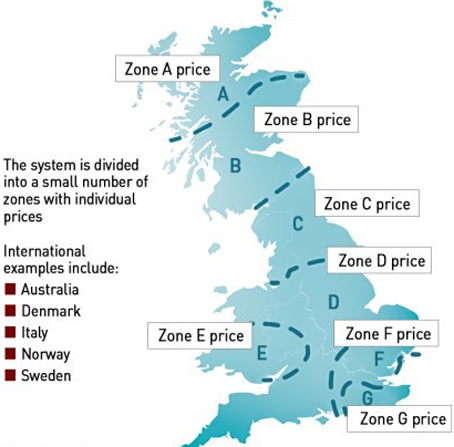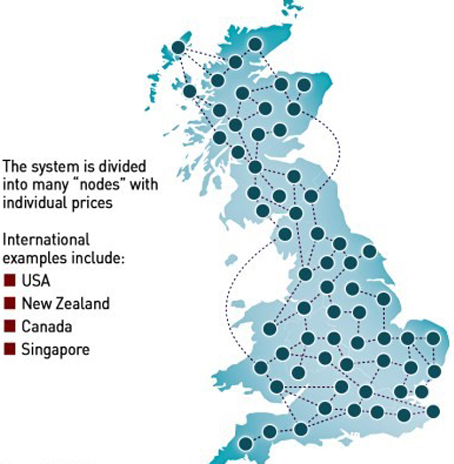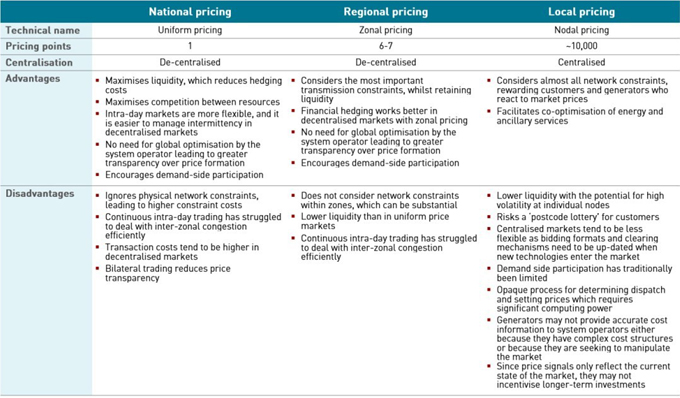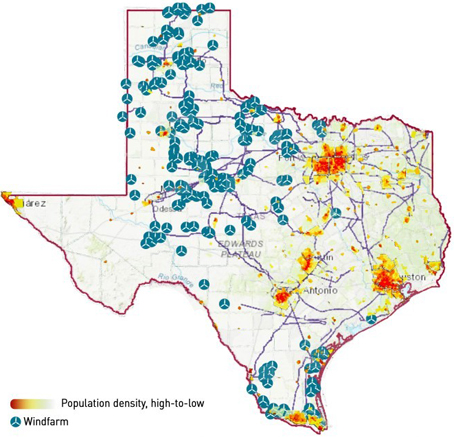
By Kathryn Porter, Watt-Logic
There has been a lot of noise recently about the prospect of a move to some form of location-based pricing in the GB electricity market. National Grid ESO is strongly in favour, seeing nodal pricing alongside a return to centralised dispatch as the best solution to the growing problem of network congestion. Energy System Catapult, Policy Exchange and Octopus Energy agree, while Regen disagrees, as do many people I have spoken with on the subject recently. Ofgem is considering the idea, among others. So what is location-based pricing and would it solve the problem of network congestion?
What’s wrong with the current pricing system?
In Britain we currently have a uniform pricing system where all participants in the wholesale markets pay the same price for energy in each settlement period regardless of their location in the country / on the network. Various network costs, some of which are locational, are charged separately, but the price of the basic trading block for any individual delivery period at any time is the same.
The main problem with this approach is that the network is considered in a sub-optimal way ahead of real time, as forward trading generally neglects network congestion inside large trading regions. In Britain we are seeing increasing wind generation being built in the north of Scotland while the main demand centres are in the south of England. A lack of transmission capacity to bring this electricity from the north to the south means that increasing amounts of wind generation has to be curtailed, and generators paid curtailment fees, which is raising the network costs paid by consumers.
This problem can be mitigated by dividing countries into several zones as in Scandinavia, by introducing flow-based zonal pricing as in Central Western Europe, or with nodal pricing (which is used in both the de-centralised market in New Zealand, and centralised markets in the US).
“…the existing wholesale market design is contributing to a dramatic rise in constraint costs and inefficiencies in balancing the network, while undermining the capability to deliver demand-side flexibility. And if left unchanged, the current national pricing model will impose excessive and unnecessary costs on consumers,”
– National Grid ESO
NG ESO believes that the changes to the location and nature of generation in the energy transition means that locational issues are now of greater importance, and the current national pricing model fails to deliver sufficiently strong locational price signals to allow network costs to be optimised. It favours a nodal pricing model with centralised dispatch, and some element of self-commitment but with prices set in the electricity pool.
What are the different pricing options?
Uniform pricing
In a national wholesale market such as that in GB, the price of electricity in any settlement period is the same for all market participants (both demand and supply) regardless of their location on the network. The System Operator (“SO”) resolves congestion by ‘re-dispatch’ – instructing selected generators and/or loads to change their schedule. In the GB initial dispatch is determined by market participants themselves under a ‘self-dispatching’ model – market participants trade with each other in the wholesale markets and those trades determine their generation and consumption in each settlement period. At Gate Closure (1 hour before the start of the settlement period), market participants notify the SO of their positions, and the SO ensures that the system is balanced at all points on the network and at all times within the settlement period by increasing or decreasing generation or consumption through the Balancing Mechanism.
Locational signals come through transmission charging which is separate from the balancing process.

Source: NG ESO
Zonal Pricing
In a zonal (or regional) wholesale market, the transmission system is divided into several zones and the wholesale price of electricity clears, for each settlement period, as a separate uniform price for each zone. The same zonal definitions are typically applied to day-ahead and balancing markets. There can be any number of price zones within a single country but in general it’s a small number – for example, Italy currently has seven zones, Sweden has four zones and Denmark has two.
When zone boundaries reflect transmission constraints, the wholesale price will vary between each zone. Transmission capacity limits between zones are reflected by variation between day-ahead energy prices for the different zones, and over time, zones that experience sustained high prices can expect to see increased investment in generation and can potentially greater investment in the transmission network to facilitate inter-zonal trading.
Nodal Pricing/ (‘Locational Marginal Pricing’)

Source: NG ESO
In markets with nodal pricing, every transmission system injection point (such as a generator busbar), offtake point (such as a distribution substation), and transmission line intersections at transmission substations, can be defined as nodes, resulting in hundreds or even thousands of nodes, each with different prices. The price at each node reflects the locational value of energy, including the cost of the energy and the full cost of delivering it including network losses and congestion.
Nodal prices are determined in real-time using an algorithm to calculate the incremental cost of serving one additional MW of load at each location subject to system constraints (such as transmission limits and maximal generation capacity). For this reason, nodal pricing is also known as locational marginal pricing (“LMP”).
Nodal pricing is used in several US markets (including PJM, MISO, CAISO, ERCOT), New Zealand and Singapore, and there are plans to introduce it in Ontario, Canada in 2023-24.
Most nodal markets require dispatching decisions to be centralised, as they were in the former Electricity Pool of England & Wales. This is also a core part of NG ESO’s proposal which would see both energy and ancillary services being co-optimised in a single centralised dispatching process.
Looking at the nodal markets in the US, they have the following features:
- Market participants engage in long-term trading in financially-settled products in order to manage their long-term electricity price risks. This is done bilaterally or on recognised financial exchanges (eg ICE, NYMEX etc);
- The system operator runs a day-ahead market which is the primary physical market which co-optimises ancillary services as well as energy. In some markets market participants can engage in bilateral trading with these trades clearing through the day-ahead market run by the SO – in some cases the prices are set by the parties and in others they are set in the pool;
- The SO also runs a real-time market which re-dispatches both generation and load to take account of any changes from the day-ahead stage. Some markets co-optimise ancillary services in the real-time market, and some do not;
- The SO provides financial instruments that allow market participants to hedge the price risks between nodes on the system. These effectively allow transmission rights or congestion charges/benefits to be traded between parties.
In the day-ahead market, generators and buyers of electricity submit their offer and bid prices to the SO, which dispatches generation to meet demand on a price merit order basis, with some adjustments to maintain system operability and the minimum run-times/capacity of assets. This process is highly automated (and also highly complex in a nodal market), where algorithms replace bilateral market trading and seek to minimise the marginal cost of energy at each node.
Comparison of different locational pricing approaches

There are some obvious challenges with location-based pricing, which I have discussed before, the main ones being, that increasing the number of pricing points will reduce trading liquidity which is already low to begin with; it is difficult to extend locational pricing to the domestic segment – people tend to object to what they see as a “post-code lottery” for pricing; and in the limit it can lead to a lot of stranded assets outside the energy sector.
“Many people on the political side are not necessarily convinced by locational pricing because you would end up in a situation where many people for example in the Lake District would be paying much less or more than people in London or vice-versa. Those regional disparities are something that as elected officials we are very aware of and don’t necessarily want to see,”
– Kwasi Kwarteng, Secretary of State for Business, Energy & Industrial Strategy
Part of the rationale for strong locational price signals is that generation and demand will seek to co-locate. However, in practice, this does not appear to happen: renewables generators want to locate where they can optimise output, regardless of the relative location of demand, while large energy users such as industry have a wide range of factors to consider when selecting a location with access to staff and telecoms connectivity being often of greater importance than energy costs. And in the aforementioned limit, it such industries did re-locate to the north of Scotland where the proliferation of wind generation would likely result in lower electricity prices, new homes and schools and hospitals would need to be built for their staff. And what then of the homes and schools and hospitals they leave behind?
“The way that TNUoS is designed encourages generators to locate close to the demand. This was appropriate for a fossil fuel-based system but now leads to disproportional charges by locations as we move to a renewables-based system,”
– Scottish Renewables in written evidence to the House of Lords Industry & Regulators Committee enquiry into Ofgem and net zero
Renewables generators in Britain already object to the relatively weak price signals in the existing market framework saying that they raise costs and dis-incentivise investment in renewable generation, potentially undermining net zero ambitions. A nodal pricing system would exacerbate this problem.
“Ofgem sets out a commitment to protecting consumers’ interests, but its network charging agenda (which ostensibly seeks to encourage the development of energy assets in locations close to major UK demand centres, minimising the cost of grid maintenance as a result) disincentivises the development of renewable assets in locations of the UK which are most suitable to host these assets, with regards to natural resource and planning (as most are located far from major demand centres).
Ofgem’s suite of network charging policies are therefore incentivising the development of less efficient forms of energy generation at the expense of more efficient forms of energy generation, e.g. onshore wind, one of the cheapest forms of energy generation,”
– Independent Renewable Energy Generators Group in written evidence to the House of Lords Industry & Regulators Committee enquiry into Ofgem and net zero
Evidence that nodal pricing reduces congestion is limited
The oldest US market with nodal pricing is Pennsylvania, New Jersey and Maryland (“PJM”). A recent report by the system operator into the impacts of the energy transition on the grid highlighted a need for market reform, since the current market design “procures less than a third of the reserves needed by the system and, with an average clearing price of $0.02/MWh, it also fails to send long-term market signals to incentivise flexibility”. The system operator is concerned that without market reform, it may be difficult to secure the levels of storage needed to support a high renewables system.
PJM has a relatively low amount of renewable generation – California’s nodal market has managed to deploy a larger amount of wind and solar, meeting 24% of electricity demand (solar: 13.2%, wind: 11.1%). California has relatively more solar compared to wind than other markets – in GB there is roughly five times more wind than solar capacity.
The data may suggest that the solar market might be better able to respond to locational price signals, but there are dangers with applying this conclusion to Britain where the levels of ‘sunniness’ vary significantly between the north of Scotland and the south of England. In May this year, California’s state energy officials warned of a potential 1,700 MW capacity shortfall which could lead to outages with drought affecting hydro output and wildfires threatening network infrastructure. Also in May, CAISO published its 20-year transmission plan, which identified a need for over US$ 30 billion in new network investment to support the energy transition – a step change in investment which highlights the difficulty of determining network investment signals in a market with nodal pricing.
“The assumption that low carbon generation would relocate in response to locational price signals is not supported by the evidence, although there could be a case that solar energy (both grid-connected and off-grid) is more locationally fluid than wind, hydro and nuclear,”
– Regen
In ERCOT there are also concerns over high levels of network congestion, with congestion costs in the real-time market of US$ 1.4 billion in 2020, up 11% from 2019. Gulf coast LNG projects among others are increasing electricity demand in locations which already have high levels of industrial demand. These areas are remote from much of the new wind capacity in the state, requiring significant new transmission infrastructure.
The Texas Panhandle area continues to experience significantly more interest from wind and solar developers than was initially planned – stability challenges and weak system strength are expected to continue to be significant constraints for export from the region. The system operator is increasingly using generic transmission constraints to limit electricity flows over some parts of the network to manage grid stability.
Location of windfarms and population density in Texas

Source: US Energy Information Administration, US Census data 2000
While it is understandable that NG ESO as a network operator wants to minimise the costs for which it is responsible, Ofgem and the Government need to resist this pressure: these costs would not go away, they would at best be shifted to other parts of the energy market and/or the wider economy.
NG ESO encourages us to look at successful nodal markets in the US, but it fails to define what “success” looks like…that it is possible to create a nodal market that works in a basic functional sense (generators generate and sell electricity and consumers buy and consume electricity) is not either surprising or interesting. But the evidence that markets with nodal pricing have managed to reduce or eliminate issues of network congestion through the transition to renewables-based grids is absent.
The answer to network congestion is more network infrastructure, not locational pricing
Moving to nodal pricing might reduce network costs, but it would achieve this by moving these costs into other parts of the value chain: if costs for wind generators increase as a result of their location in windy places, those costs will be passed back to consumers, who won’t care if the cost is called a generation cost or a network cost.
The fundamental reason for network constraints is a lack of adequate network investment, which in markets of all types – uniform, zonal and nodal – is failing to keep pace with the needs of the energy transition. NG ESO even acknowledges this, saying that various stakeholders told it that “insufficient transmission network build is the fundamental cause of constraints, and this applies to any wholesale market design”.
In other markets with zonal pricing (Norway) and nodal pricing (CAISO, ERCOT and others) we see an ongoing need for major network investments. In fact it could be argued that locational pricing weakens the price signals and incentives for network investments while failing to reduce congestion by incentivising a more optimised use of existing infrastructure, leading to the worst of both worlds. There may well be a need for market reform, but a move to location-based pricing is not the answer to the issue of network congestion.
Original article l KeyFacts Energy Industry Directory: Watt-Logic
 KEYFACT Energy
KEYFACT Energy